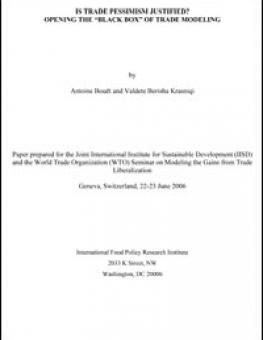
Is trade pessimism justified? Opening the "black box" of trade modeling
June 2006: In the early years of this decade, as the World Trade Organization's Doha Round negotiations began to take shape, simulations of the welfare gains from complete liberalization of merchandise trade were suggesting the world economy would be as much as $800 billion richer with an ambitious and successful Round, and that approximately two-thirds of these gains would be appropriated by developing countries. Over the last two years, however, simulations of the welfare gains from full multilateral trade liberalization have yielded much smaller values than were being touted only a few years ago. Moreover, the gains for developing countries appear now to be vanishingly small.
The rationale for liberalizing trade - reducing or eliminating tariffs and certain subsidies - is built on fundamental assumptions about the world economy, and mathematical representations of how producers and consumers react to changes in relative prices, changes to policy, etc. Trade economists have incorporated these assumptions and relationships into large economic models that are solved with the aid of computers. At the heart of most large, multi-country modeling efforts are so-called computerized general equilibrium (CGE) models. With data on trade and other variables, these CGE models can be used to make predictions about changes in economic variables were trade to become more liberal.
While experts understand the reasons for the downward revisions in these trade models, many trade negotiators remain confused. Adding to their confusion are some important variations in the simulation results carried out by different modelers. Meanwhile, critics point to the many limitations of the models and the estimates they generate, and question the extent to which they should be informing trade policy at all.
This report analyses why trade modeling has produced such diverging results, as well as discussing the conclusions that all models have drawn in common.
You might also be interested in
Will the Inclusion of Voluntary Standards in Trade Agreements Lead to More Sustainable Trade?
The use of voluntary sustainability standards (VSSs) and similar systems in free trade agreements (FTAs) is gaining traction. Will it lead to more sustainable production and consumption globally?
Strategic Environmental Assessment for the Mining Sector
Strategic environmental assessments (SEA) are an essential tool for policy-makers working to develop a sector-wide vision for responsible mining.
Blackouts and Backsliding: Energy subsidies in South Africa 2023
Blackouts and Backsliding presents the latest energy subsidy data for South Africa.
Sustainable Asset Valuation of Parques del Río Norte in Medellín, Colombia
This economic valuation demonstrates the benefits of expanding urban green space in the city of Medellín, Colombia.